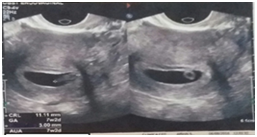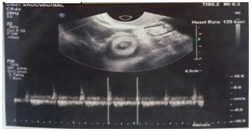eISSN: 2377-4304


Case Report Special Issue Reproductive System & Sexual Disorders
1Department of Obstetrics and Gynecology, Ribeirao Preto Medical School, University of Sao Paulo, Ribeirao Preto, Brazil
2Faculty of Medicine Est
Correspondence: Marcela de Alencar Coelho Neto, Department of Obstetrics and Gynecology, Ribeirao Preto Medical School, University of Sao Paulo, Ribeirao Preto, Brazil, Tel 55(88)99251?9481
Received: November 16, 2017 | Published: November 30, 2018
Citation: Net MAC, Novais IG, Maia SF, et al. Heterotopic pregnancy after in vitro fertilization / intracytoplasmic sperm injection: case report. Obstet Gynecol Int J. 2018;9(6):480-481. DOI: 10.15406/ogij.2018.09.00390
Heterotypic pregnancy is a rare cause of acute abdomen, characterized by the coexistence of an intrauterine and an ectopic gestation simultaneously.1-6 In the early stages, the diagnosis is challenging, as a consequence of the existence of the concomitant intrauterine gestation.5
The prognosis depends mainly on the early diagnosis and the surgical technique used in the treatment.5 Studies show that 35% of the patients evolve with loss of the intrauterine pregnancy7 and 26.6% of the patients have premature labor.4 In a series of cases, the live birth rate was 66.7%.4 This article aims to report a case of a patient diagnosed with tubal heterotopic pregnancy after in vitro fertilization/ Intracytoplasmic injection (IVF/ICSI). The patient was surgically treated and progressed with the viability of intrauterine gestation, and she was followed up until the delivery.
A patient of 36 years old, with previous history of infertility for 5 years due to polycystic ovary syndrome underwent some unsuccessfully low-complexity infertility treatments, then she underwent IVF/ICSI in October 2015. The patient opted for freezing-all embryos for subsequent transfer. In June 2016, two frozen-thawed embryos were transferred in the blastocyst stage. Twelve days after the embryo transfer, the pregnancy test using quantitative Human Beta-Gonadotrophin Assay (beta-hCG) resulted in 462.91 mIU/mL. Two days later she presented severe pain in the lower abdomen and transvaginal bleeding.
On physical examination, the patient was hemodynamically stable and there were nosigns of peritoneal irritation. At the vaginal exam, the cervix was closed. Serum concentrations of beta-hCG, with a 48-hour interval, increased at a rate of 51%. The patient progressed with the improvement of pain and bleeding.
Twelve days after performing the first beta-hCG, a transvaginal ultrasonography (USTV) was performed, which showed topical gestation with a single embryo presenting heartbeats and biometry compatible with the gestational age of 7 weeks and one day (Figure 1); there was also a simple cyst in right ovary (volume 33.8 cm³) and an image in the right adnexal region suggestive of ectopic pregnancy (Figure 2).

Source: Marcelo Pierre Medical Center Archive.
Figure 1Uterus is containing gestational sac inside. 1A-Embryo. 1B-Vitelline vesicle.

Figure 2 Adnexal image suggestive of ectopic pregnancy, characterized by embryo presenting heartbeats.
Source: Marcelo Pierre Medical Center Archive.
On the same day of the USTV, the patient underwent exploratory laparotomy. There was a ruptured ectopic pregnancy in the right side fallopian tube, with a small amount of blood in the abdominal cavity and a simple cyst in the right ovary (which ruptured during the surgical procedure). Salpingectomy and right oophoroplasty were performed without complications. USTV performed in the day after the surgery showed intrauterine live embryo. The pregnancy progressed uneventfully. The patient delivered a healthy baby after 38 weeks and 6 days of pregnancy with good vitality and weighing 3,605kg.
Although it is a rare pathology in spontaneous pregnancies (1: 30,000), its incidence has increased after the use of assisted reproduction techniques (ART)(1: 100).6,8,9 Even so, it is an infrequent condition what justifies the report of this case. There are factors that reduce the risk of heterotopic pregnancy after IVF, such as reduced amount of embryos transferred (two or less), correct placement of the catheter during the transfer (less than 5 mm from the uterine fundus), loading the catheter with small volume , transfer of the embryo on the third day of evolution and the use of cryopreserved embryos.10,11 In the present case, the patient received two embryos in the blastocyst stage.
The symptomatology of the heterotopic pregnancy is nonspecific and may be asymptomatic in 10% of cases12 or present with symptoms such as amenorrhea, transvaginal bleeding and pain, as reported by the patient in the present case. The serum levels of Beta-hCG usually do not help in the diagnosis of heterotopic gestation, since due to the coexistence of intrauterine gestation, they will be elevated.5 In the present case, the positivity of beta-hCG and its increasing values within 48 hours speak in favor of an intrauterine pregnancy evolving within normal, where beta-hCG concentrations> 1500-2000mIU / mL are expected with an increase of 50- 66% in 48 hours.12
In patients at high risk for ectopic or heterotopic pregnancy, especially those who underwent assisted reproduction treatments, USTV screening should be performed around 4 weeks after embryo transfer.13 Thus the diagnosis of heterotopic pregnancy is usually made earlier. The treatment aims to maintain the intrauterine pregnancy and remove the extrauterine pregnancy as soon as possible.14 The surgical treatment consists in the removal of extrauterine gestation, and it can be by laparoscopy or laparotomy.15 The patient underwent right salpingectomy via laparotomy, the gold-standard technique for ectopictubal pregnancy.16
Although the rate of miscarriage and preterm delivery of intrauterine pregnancy is higher when the resolution of extrauterine pregnancy is by laparotomy, the patient in this report presented a good prognosis for intrauterine pregnancy. This was mainly due to obtaining an early diagnosis of heterotopic pregnancy and because the patient did not present hemodynamic instability.
This work had as main limitation its design because it is a report of an isolated case. The monitoring of the patient until the delivery allowed the obtain the main outcome of studies in reproductive medicine, to evaluate if there was a live birth, which is a relevant point of this study.
The occurrence of heterotopic gestation has become increasingly frequent. Given this context, it is important to consider this diagnostic hypothesis in patients presenting risk factors. Once this is a condition that manifests through nonspecific symptoms, and there is a concomitant intrauterine pregnancy, early diagnosis is challenging. However, monitoring adequately patients submitted to IVF/ICSI has facilitated diagnosis and decreased the rate of maternal and fetal death. Early surgical treatment, preferably through salpingec to my, contributes to the preservation of intrauterine pregnancy.
None.
The author declares no conflict of interest.

©2018 Net, et al. This is an open access article distributed under the terms of the, which permits unrestricted use, distribution, and build upon your work non-commercially.